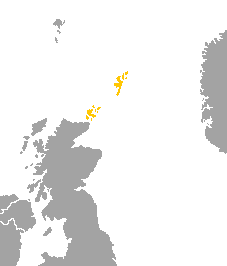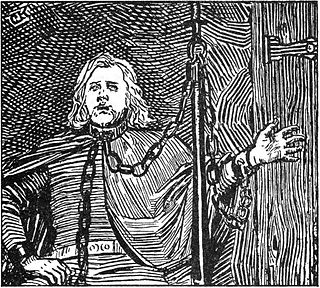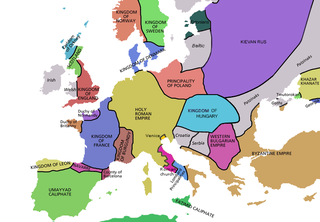
Norn is an extinct North Germanic language that was spoken in the Northern Isles off the north coast of mainland Scotland and in Caithness in the far north of the Scottish mainland. After Orkney and Shetland were pledged to Scotland by Norway in 1468–69, it was gradually replaced by Scots. Norn is thought to have become extinct in 1850, after the death of Walter Sutherland, the language's last known speaker, though there are claims the language persisted as late as the 20th century.

The Viking Age was the period during the Middle Ages when Norsemen known as Vikings undertook large-scale raiding, colonizing, conquest, and trading throughout Europe and reached North America. It followed the Migration Period and the Germanic Iron Age. The Viking Age applies not only to their homeland of Scandinavia but also to any place significantly settled by Scandinavians during the period. The Scandinavians of the Viking Age are often referred to as Vikings as well as Norsemen, although few of them were Vikings in the technical sense.

The Orkneyinga saga is a narrative of the history of the Orkney and Shetland islands and their relationship with other local polities, particularly Norway and Scotland. The saga has "no parallel in the social and literary record of Scotland" and is "the only medieval chronicle to have Orkney as the central place of action". The main focus of the work is the line of jarls who ruled the Earldom of Orkney, which constituted the Norðreyjar or Northern Isles of Orkney and Shetland and there are frequent references to both archipelagoes throughout.

The Norsemen were a North Germanic ethnolinguistic group of the Early Middle Ages, during which they spoke the Old Norse language. The language belongs to the North Germanic branch of the Indo-European languages and is the predecessor of the modern Germanic languages of Scandinavia. During the late eighth century, Scandinavians embarked on a large-scale expansion in all directions, giving rise to the Viking Age. In English-language scholarship since the 19th century, Norse seafaring traders, settlers and warriors have commonly been referred to as Vikings. Historians of Anglo-Saxon England distinguish between Norse Vikings (Norsemen) from Norway who mainly invaded and occupied the islands north and north-west of Britain, Ireland and western Britain, and Danish Vikings, who principally invaded and occupied eastern Britain.

A Skald, or skáld, is one of the often named poets who composed skaldic poetry, one of the two kinds of Old Norse poetry, the other being Eddic poetry, which is anonymous. Skaldic poems were traditionally composed on one occasion, sometimes extempore, and include both extended works and single verses (lausavísur). They are characteristically more ornate in form and diction than eddic poems, employing many kennings and heiti, more interlacing of sentence elements, and the complex dróttkvætt metre.
Sagas are prose stories and histories, composed in Iceland and to a lesser extent elsewhere in Scandinavia.
Rognvald Eysteinsson was the founding Jarl of Møre in Norway, and a close relative and ally of Harald Fairhair, the earliest known King of Norway. In the Norse language he is known as Rǫgnvaldr Eysteinsson (Mǿrajarl) and in modern Norwegian as Ragnvald Mørejarl. He is sometimes referred to with bynames that may be translated into modern English as "Rognvald the Wise" or "Rognvald the Powerful".
Einarr Rognvaldarson often referred to by his byname Torf-Einarr, was one of the Norse earls of Orkney. The son of the Norse jarl, Rognvald Eysteinsson and a concubine, his rise to power is related in sagas which apparently draw on verses of Einarr's own composition for inspiration. After battling for control of the Northern Isles of Scotland and a struggle with Norwegian royalty, Einarr founded a dynasty which retained control of the islands for centuries after his death.
Aud the Deep-Minded, also known as Unn, Aud Ketilsdatter or Unnur Ketilsdottir, was a 9th-century settler during the age of Settlement of Iceland.
Thorfinn Torf-Einarsson also known as Thorfinn Skull-splitter was a 10th-century Earl of Orkney. He appears in the Orkneyinga saga and briefly in St Olaf's Saga, as incorporated into the Heimskringla. These stories were first written down in Iceland in the early 13th century and much of the information they contain is "hard to corroborate".
The Papar were, according to early Icelandic sagas, Irish monks who took eremitic residence in parts of what is now Iceland before that island's habitation by the Norsemen of Scandinavia, as evidenced by the sagas and recent archaeological findings.
Ketill Björnsson, nicknamed Flatnose, was a Norse King of the Isles of the 9th century.

The Earldom of Orkney is the official status of the Orkney Islands. It was originally a Norse feudal dignity in Scotland which had its origins from the Viking period. In the ninth and tenth centuries it covered more than the Northern Isles (Norðreyjar) and included Orkney, Shetland, Caithness, and Sutherland. The ruling position of Jarl or Earl of Orkney was heritable.
Sigurd Hlodvirsson, popularly known as Sigurd the Stout from the Old Norse Sigurðr digri, was an Earl of Orkney. The main sources for his life are the Norse Sagas, which were first written down some two centuries or more after his death. These engaging stories must therefore be treated with caution rather than as reliable historical documents.
Icelandic literature refers to literature written in Iceland or by Icelandic people. It is best known for the sagas written in medieval times, starting in the 13th century. As Icelandic and Old Norse are almost the same, and because Icelandic works constitute most of Old Norse literature, Old Norse literature is often wrongly considered a subset of Icelandic literature. However, works by Norwegians are present in the standard reader Sýnisbók íslenzkra bókmennta til miðrar átjándu aldar, compiled by Sigurður Nordal on the grounds that the language was the same.

Hákonar saga Hákonarsonar or Hákonar saga gamla is an Old Norse Kings' Saga, telling the story of the life and reign of King Haakon Haakonarson of Norway.
Brusi Sigurdsson was one of Sigurd Hlodvirsson's four sons. He was joint Earl of Orkney from 1014. His life is recorded in the Orkneyinga Saga.
Hildr or RagnhildrHrólfsdóttir was a 9th-century woman who is referenced in various Old Norse sources including Óláfs saga helga, Orkneyinga saga, and Landnámabók and is also one of the few female skalds from whom verses survive.

Scandinavian Scotland refers to the period from the 8th to the 15th centuries during which Vikings and Norse settlers, mainly Norwegians and to a lesser extent other Scandinavians, and their descendants colonised parts of what is now the periphery of modern Scotland. Viking influence in the area commenced in the late 8th century, and hostility between the Scandinavian earls of Orkney and the emerging thalassocracy of the Kingdom of the Isles, the rulers of Ireland, Dál Riata and Alba, and intervention by the crown of Norway were recurring themes.
"Hildina" is a traditional ballad thought to have been composed in Orkney in the 17th century, but collected on the island of Foula in Shetland in 1774, and first published in 1805. It tells a story of love, bloodshed and revenge among characters from the ruling families of Orkney and Norway. This ballad is written in Norn, the extinct North Germanic language once spoken in Orkney and Shetland, and is the only surviving work of any length in that language. It is one of two Norn ballads included in The Types of the Scandinavian Medieval Ballad, where it is classified as type E 97.







